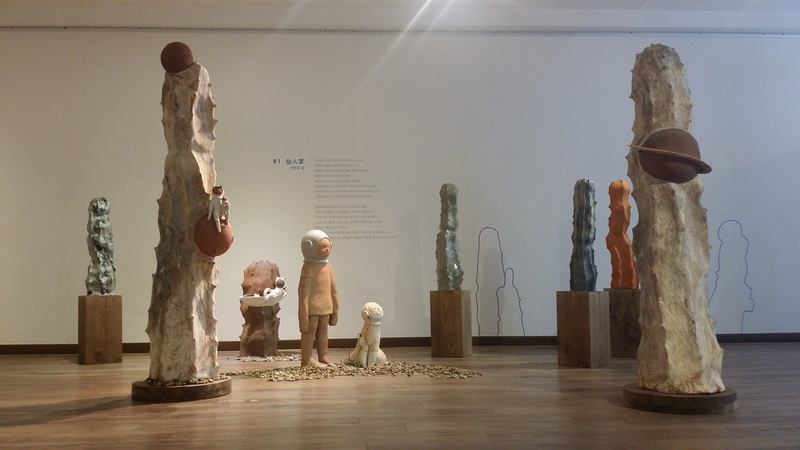Choi Soon-im: Borderless Traveler in the Arts
By Kang Jennis Hyun-suk
Have you heard of the Montmartre hill of Gwangju? This is where about 20 artists’ studios and several art galleries are located in a small neighborhood in Yangnim-dong. Some people call this Yangnim locale the Montmartre of Gwangju. Walking up this hill in Yangnim-dong, you might see a cat stretching its back on a fence. The cat’s name is Yangyang, and it is made of terracotta. There is a small café near Yangyang, and in front of the café, there are a couple of statues. The small girl statue is crouching under some raindrops, and the large cat statue is sitting slightly away from her, stretching his big paw over the girl’s head to protect her from the falling raindrops. They look like cartoon characters that have jumped out of their screen. It was fun to see these two statues, and they made me wonder who created these striking works of art. I opened the café door and walked in. The inside looked more like a small exhibition hall than a café.
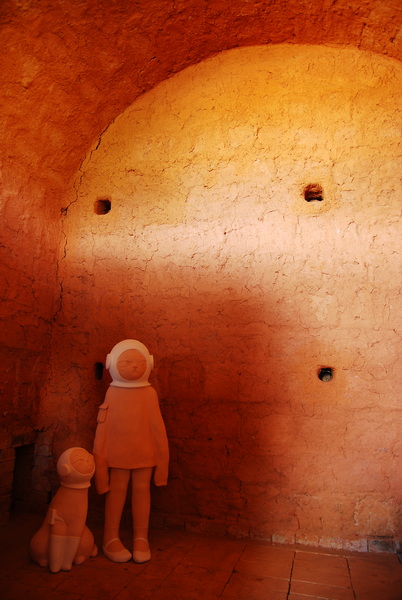
The artist was not at the café, as she was at an exhibition that she was holding in another city. I could not meet her that day, but I enjoyed admiring her fantastic works over a cup of coffee. On the wall, there were drawings, ink paintings, oil paintings, watercolor paintings, and acrylic works. Below them were three-dimensional terracotta and ceramic artworks appearing as if they had jumped out from the drawings on the wall. I was surprised that this variety of artworks was made by a single artist.
This single artist was Choi Soon-im, and soon after my first café visit, I was able to meet her at her gallery-cafe that serves as a window into artistic empathy, conveying warmth to all who visit this cozy café in the Yangnim art village. She was happy to sit for this interview.
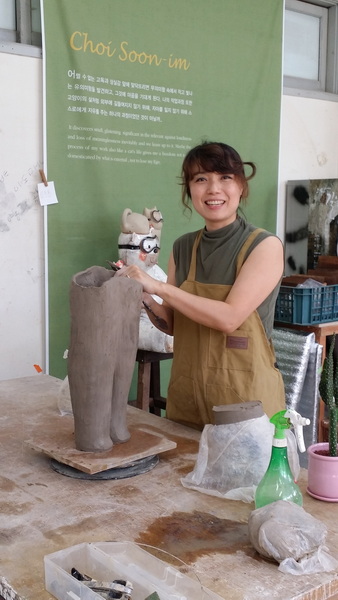
Jennis: Thank you for making time for this interview. Actually, I saw your artworks in the art polygon on the sacred tree hill in Yangnim-dong. I remember the drawing of a woman on the torn page of a book. And there was a red star-like object shining on her chest.
Choi Soon-im: Oh, you came to the exhibition. The title of the book was The Old Man and the Sea. I took the book with me when I went to the hospital to have breast cancer surgery. I pondered on the old man fulfilling his calling as a fisherman, though all that he returned with for all his effort was the huge marlin’s skeleton. Maybe I thought I needed the courage of the old man fighting the marlin all alone on a lonely sea. In the hospital, I tore a page out of the book and drew myself with no hair because of the chemotherapy.
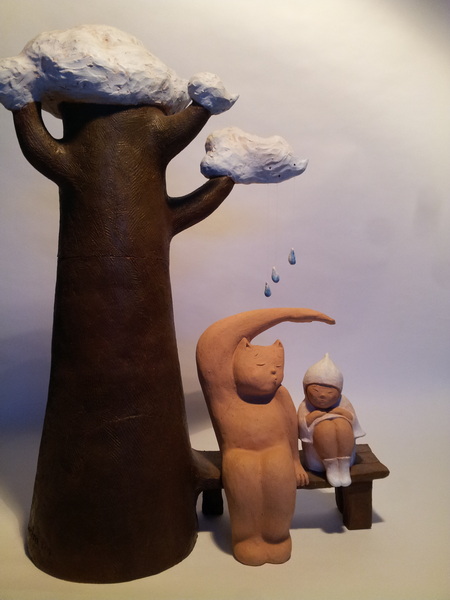
Jennis: The red on the chest looked like a shining star to me. I think artists’ pain or difficulties bring maturity to their hearts. How did you get into the field of art?
Choi Soon-im: I spent my childhood in Yangnim-dong. I went to elementary and middle school in Yangnim-dong, and I spent my Sundays at a church in Yangnim-dong that was built by missionaries. At church, I made backgrounds for the Christmas plays every year. Having loved drawing and making artistic things since childhood, I naturally majored in art in college.
Jennis: Your works are fantastic and fairytale-like, so I am sure that children would like your works, too. Where do you think the inspiration for your works originated from?
Choi Soon-im: I love children. I liked spending time with them at Sunday school in church. I majored in art, but I thought what I really wanted to do was be with little kids. So, I asked my professor to write a recommendation for me to work at a kindergarten. I think my works come from the innocence of the children that I have met over the years.
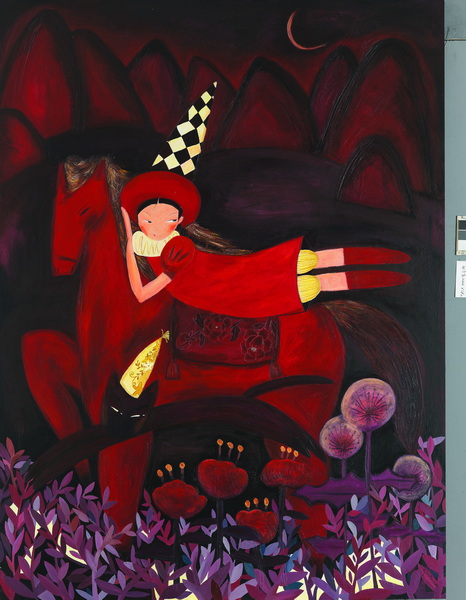
Jennis: Wow, the drive to decide and implement what you wanted to do even before graduating from college is amazing. I think it is very rare for someone who majored in art to teach kids in kindergarten. How was your experience as a kindergarten teacher?
Choi Soon-im: At first, I taught only six-year-olds, but kids from different age groups also wanted to take my art classes, so I held after-school classes. As time passed, I opened my own art academy for kids, and I used almost everything I learned in college to teach the children in my various art classes. It gave me a lot of joy; I loved to teach the six-year-olds’ class, as they were not yet trapped into a standard way of thinking.
Jennis: I heard that playing with clay helps develop muscles in the hands and neural networks in the brain. It seems that you were so busy with teaching that you must not have had time for your own creative activities after graduating from college. When did you start creating your own artworks?
Choi Soon-im: Actually, I have never been away from having clay in my hands. Since I was in college, I have been working in my own space on the balcony of my apartment. I studied more about diverse art techniques to teach children, and I was touched by the children’s sparkling ideas. However, as I was in my late 30s, I felt that I had no serious works as an artist. I wanted to hold an exhibition to confirm that I was still devoted to the arts. So, I had my first individual exhibition ten years ago.
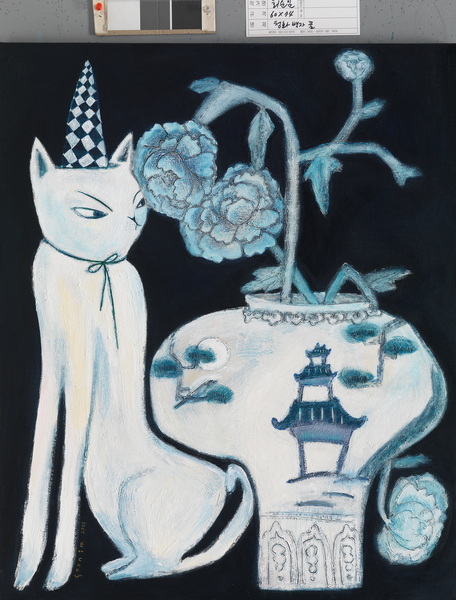
Jennis: Was it after that exhibition that you decided to go to graduate school?
Choi Soon-im: Since 2010, I have been working with my own kiln and personally doing research on how the soil changes in the kiln with various glazes. Some people like my artworks, but others have different opinions. Some said that my works were childish, but I asked myself, “Why do I like and make these works that some might think seem childish?” I wanted to have an objective view of my works, so I decided to go to graduate school. I studied the meaning of childhood innocence. The more I read and studied, the more I realized that childhood innocence is a deep concept. The philosopher Nietzsche also comforted me with his words that we should try to be a pure, childlike person. Furthermore, by doing art, I began to prove my existence as an artist, and this helped me overcome the difficulties in my life.
Jennis: I heard you had an exhibition in Japan. How did that come about?
Choi Soon-im: When the Gwangju Museum of Art was recruiting artists for a residency in Japan, I applied for it with the Japanese language-learning component. I was accepted and through the residency, I was able to work in both Yokohama and Sapporo. The exhibition was part of the residency.

Jennis: Do you have any memorable episodes from your residency in Japan that you would like to relate?
Choi Soon-im: It was 2017 when I went to Japan. I worked in Sapporo at the beginning of that year and later stayed in Yokohama. It was a good experience to experiment in my work using the materials available in Japan. The Japanese audience showed favorable interest in my cat works. Perhaps it was because the Japanese are used to living with cats in the house. An interesting episode is that my husband came to see me on a bike. He traveled on his bike from Gwangju to Busan, loaded it on a ferry, and then rode across Japan from the port to Yokohama, where I was. It took him six days. He said that he had come for me to ride on the back seat.
Jennis: Your husband appears to be a romanticist. That was really touching.
Choi Soon-im: I call him a “big cat.” Cats do not show their warm feelings as apparently as dogs do. But like the statue you saw, the cat holds out his arm to keep the girl from getting wet when it rains.
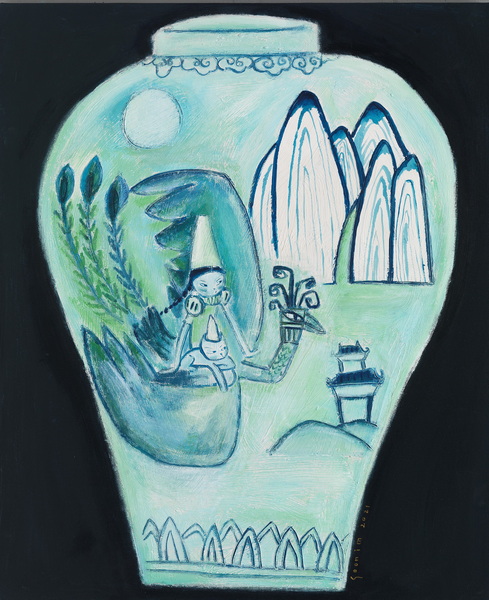
Jennis: That is really nice. Is there a special reason you decided to open a studio and exhibition space in Yangnim-dong?
Choi Soon-im: As I was at the residency studio in Japan and focused on my work day and night, my body seemed to have been under a certain amount of strain. So, when I came back to Korea, I took time to take care of myself. However, some parents asked me to give their children an art class just once a week, so I made a small space in Yangnim-dong for that. We played with clay, drew, or went to nearby art museums every Saturday.
Jennis: I am sure that the students couldn’t help but be happy in your art classes. Your artworks are so interesting. How do you come up with such fresh ideas?
Choi Soon-im: I often get surprised when I draw with my students. In an art class, a boy drew a very big-mouthed crocodile with a very short tail. His sister asked him why the crocodile looked like this, and the boy said, “This crocodile is a very angry one.” If I were to be asked what I have gained throughout my life, I think I would have to say it is the sensitivity to communicate with children. To be honest, I think that I am less adapted to socializing in adult society.
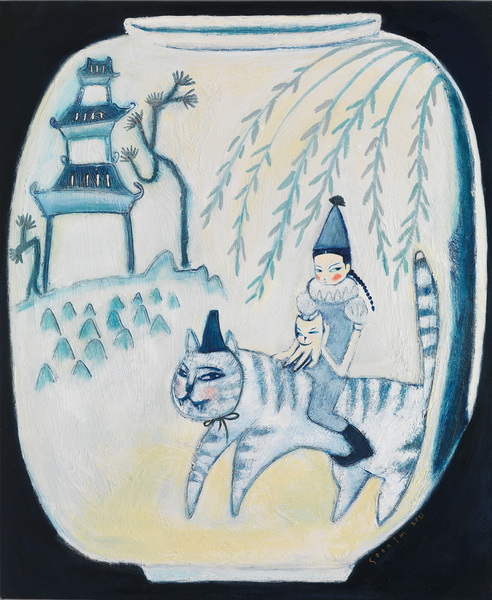
Jennis: Your works are quite diverse. With only your flat works, you draw with various materials such as oil paints, watercolors, acrylics, pencils, and ink. And for your three-dimensional artworks, you use soil, iron, stone, and FRP (fiber-reinforced plastic) as materials. It seems that your use of materials knows no borders. I think it would be hard to find another artist who works with such a variety of materials. You are like a singer who has a wide vocal range and performs with a diverse array of musical instruments such as the cello, piano, and drums.
Choi Soon-im: Thanks. Pablo Picasso said this: “I draw what I think, not what I see.” For us, Picasso is well known as a painter, but he did not get trapped with only one way to express his thoughts. Not many people know that he made pottery and embodied his thoughts that way, too. As a sculptor, I am curious about various materials and not afraid to use new ones.
Jennis: At first, I wondered what I should call you, a sculptor or a painter. Some people call you a ceramic sculptor. What exactly is that?
Choi Soon-im: A ceramic sculptor might be a little unfamiliar to many people. In order to understand what ceramic sculptures are, you need to understand the plastic arts first. The plastic arts are art forms that involve physical manipulation of a plastic medium by molding or modeling them into things such as sculptures or ceramics. It is commonly referred to as sculpture, or a three-dimensional work made of various materials.

To make such sculptures, you first apply plaster to the figure made of clay. Be sure to apply soap between the sections of plaster to make it easier to separate after the plaster dries. When the plaster is dry, carefully remove the plaster sections along the lines of soap that you applied earlier. Dig out all the clay inside the plaster sections. After wiping the inside of the plaster cleanly, pour the sculpture material, such as bronze or FRP, into the plaster. When the material has hardened, break off the plaster mold and gloss or color the sculpture.
These are the basics of how to make a sculpture. Clay has been used almost totally in the process of making sculptures, but I wanted to use clay as the completed work itself. So, I began to make terracotta and ceramic sculptures using the coiling technique. The “coiling” technique uses clay and forms it into long, round coils that are stacked.
Jennis: You should have three-dimensional vision in order to create figures using your stacking process. Since the inside is empty, the sculpture could collapse if it is not balanced during the stacking process. For the last question, what are your plans for the future?
Choi Soon-im: From December 1–12, there is an exhibition at the Gwangsan-gu Sochon Art Factory. The title of the exhibition is “Myoyeon” (묘연). It refers to a loving relationship with a cat. I have been working on my “Traveler” series in different ways for quite some time, and now I am thinking of another journey – travels with a stray cat, and me living with her.
In Closing…
While listening to the explanation of the procedure for sculpting from artist Choi Soon-im, I thought that the process of sculpting was much like life itself: A creature can come out into this world only after breaking through the hard outer shell.
Photographs courtesy of Choi Soon-im.
The Interviewer
Kang Jennis Hyunsuk has been living in Gwangju all her life. She has painted as a hobby for almost a decade, and she has learned that there are so many wonderful artists in the Gwangju area. As a freelance interpreter, she would like to introduce the English-speaking world to the diverse sphere of Korean art. Her goal is to interview 100 artists!





